[A friend of mine who was in Bethlehem with me had the chance to go to the Gaza Strip for a few days, and I asked him if I could put his account of his time there on this blog. He said yes, and if you have any questions for him, as he mentions at the end of the email, you can email him here. All photos property of Leif Carlson.
Hello everyone,
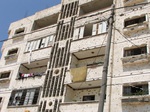
A lot has happened in the last week and I am finding it difficult to know where to begin. I was invited by an international aid organization called the Norwegian People’s Aid to attend a conference in Gaza for the last 6 days. For those of you who don’t know what Gaza is, I’ll try to give a brief description. The situation in Gaza is even more desperate than the conditions in the West Bank. Gaza is an area of land about twice the size of Washington DC (360 square kilometers). Forty percent of that land is controlled by Israeli settlers who only number around 7,000 people. The remaining sixty percent of the land is used by over 1.3 million Palestinians. The Palestinians are basically squeezed into horrible conditions with a lack of basic human needs. Many of them have no clean water or access to medicine. Gaza is currently facing some of the worst human rights violations at the hands of the Israeli government and settlers. I saw many signs of these human rights violations in the 6 days that I was there, and I am now finding it really difficult to know how to use this experience to make the situation better. All I think I can do at this point is talk about what I have seen and heard in the hope that it will change the way the world views this situation.
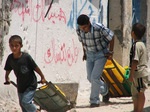
Like I said above, I was invited to attend a conference through the Norwegian People’s Aid organization. The purpose of the conference was to work with Palestinian youth (18 – 25 years old) from Gaza on issues of civil responsibility, the importance of volunteering, and citizenship in democracy. It was a good opportunity to meet with Palestinian youth and hear their perspectives on the future of Palestine and specifically Gaza. We attended this conference for several days and we toured the areas around Gaza City in the evenings. One of the men working for NPA is named Mohammed and he was our guide, driver, and friend while we were there. He is an amazing photographer who has captured some horrifying images over the last few years in Gaza. So, he knew where to take us in the area to see some of the worst conditions, yet also knew what to avoid in order to keep us safe. I won’t lie to anyone about the danger of going to Gaza. The US government actually states that all Americans in Gaza should depart immediately. Yet, they claim that the danger is from “terrorists” who plan to attack Americans, not Israeli soldiers carrying out acts of indiscriminate killing. While it is very dangerous in Gaza right now, I still felt the need to go and see for myself what is going on there. I believe that if I am to be a better advocate for human rights, I must see some of the worst forms of human suffering on the planet. My group did get to see evidence of this suffering and I believe that we are all changed for having gone.
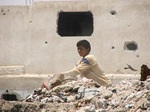
There are several refugee camps that surround Gaza City in the northern part of Gaza. We went through one of the refugee camps called Jaballia, which was hit pretty hard last fall in an Israeli attack that left over 150 Palestinian civilians killed, including women and children. Several hundred homes were also completely destroyed during this attack. We saw many remains of homes, mosques, and Palestinian Authority government offices. The landscape is mostly rubble and the ruins of people’s lives. It is extremely sad to see children sitting in the rubble because they have no where to go. The houses that remain standing are covered with bullet or mortar impact marks. It is amazing that many of these houses can still stand, and that they are being lived in. There is no reason why these families must face this type of oppression.
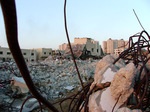
My group also had a chance to travel to the south for an intended one-day trip to see the cities of Rafah and Khan Yunis. I say “intended one-day trip” because it lasted a little longer than a day and I’ll explain this later. We had to pass through the Abu Holi checkpoint to go to the south. Actually, it is amazing that this checkpoint was open because it is often closed for long periods of time. This creates a lot of problems for the Palestinian people who cannot travel from the north to the south or vise-versa. Many people are forced to live in their cars at the checkpoint for weeks on end waiting to return to their families. On this day, we actually sailed right through the checkpoint headed south. We went straight to Rafah and it was apparent that the stories of the destruction there are true. So much of the city is in ruins, and I don’t remember seeing a single structure that hadn’t been hit by bullets, mortars, or rockets at least once. Yet, most of the structures look like Swiss cheese. We drove through many of the refugee camps and met with some people who are running a youth program in an attempt to offer some hope to the children of Rafah. We also met with a man who took us into his home to show us where his three mentally-challenged children were sleeping when Israeli tanks opened fire on his house. He showed us where he had been shot several times trying to get his family to safety. It was utterly amazing to hear his story and see the pain on his face.
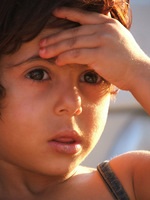
We moved quickly from one place to the next for our own safety. There is really no place in Rafah that isn’t within view of an Israeli observation tower. There are snipers in these towers who have the standing order to shoot anyone who raises binoculars, a camera, or even for looking at the tower for too long. You need to realize that this order applies for everyone, be it children, the elderly, women, men, Palestinians, and even Internationals. The soldiers do not discriminate against who they will kill if they want to. We stayed out of view of these towers and the tanks as much as possible. We didn’t want to chance anything. Actually, when our group was touring an SOS village (an orphanage), the Israelis in the nearby tower shot into the compound at least twice to let us know that they didn’t like us being there. It was quite frightening to realize that these soldiers were willing to shoot into an orphanage just to get us to leave. Unfortunately, not even this orphanage can be an island of peace and it has been shot at repeatedly since it opened.
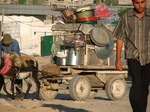
After that we made our way back to the Abu Holi checkpoint and soon realized that it had been completely closed down. The line of vehicles was at least 2 miles long and we knew that we would be waiting for awhile. We made our way to the front of the line and sat with other official vehicles (UN, Red Cross, Doctors without Borders) waiting for clearance to pass. We ultimately waited all day and were told repeated lies by the Israelis that the checkpoint would open in only 30 minutes. We made several calls to the Israeli general in charge at the checkpoint but it was of no use. There were several incidents at the checkpoint that we witnessed, from the beating of Palestinian youth by Palestinian Authority soldiers, to Palestinian Authority riot police being brought in to stand between us and the Palestinians waiting in line. It was feared that if the official vehicles were allowed to pass and the Palestinian people were not that a riot would break out and the Palestinian people would be held back by force or shot on sight.
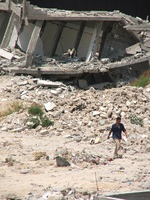
It was an intense day and it lasted well into the night. Around 11:30 we decided to head back to Khan Yunis to find a place to stay and we ended up at a Red Crescent hostel. We only got a few hours of sleep before we had to head back to the checkpoint in the morning. Again it was several hours of waiting, but this time we made some other phone calls to the American Embassy in Tel Aviv. Within 30 minutes of the Embassy receiving our passport information and the threat of a pending medical emergency, the checkpoint was opened. The mood in the crowd was so high. People were cheering and honking their horns. Even we were extremely relieved to be getting through. We finally managed to make our way home several hours later, where we all proceeded to sleep for several hours. I don’t think we were ready to fully appreciate what we had gone through just yet.
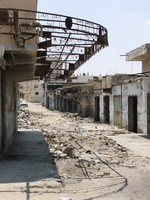
In the last day we were in Gaza City, Mohammed showed us some of his photos and videos. The pictures were unbelievable. He was the only photographer on hand when the American Rachel Corrie was killed by an Israeli bulldozer. She worked for the International Solidarity Movement and was standing in front of a house to prevent it from being demolished when the bulldozer charged at her and killer her instantly. The photos were awful and it is still hard to think of those images. Mohammed also showed us a video of a parade in Rafah where Palestinians were chanting for Israel to give them some time to get milk and food for their children. The Israeli response to this non-violent parade was for an Apache helicopter to shoot a rocket into the middle of the crowd. Mohammed captured it all on tape and the chaos that soon followed. Many people were killed instantly and most of them were children. Fathers were carrying the broken bodies of their kids to the nearest ambulance. Then, the helicopter rocketed the ambulance as well. I couldn’t believe my eyes! What would ever drive the Israeli military to think it is appropriate to shoot an air-to-surface missile into a crowd of civilians and then at an ambulance? I am still reeling from this sight and the knowledge that we had stood right in the area of Rafah where this attack happened. I don’t think I will ever look at things the same way again after seeing that. I’m sorry to share such graphic stories with you all, but I think it is important for people to hear about these things when I know that the American media never covers these events.
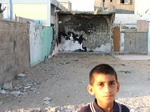
So, we made it back through the Israeli checkpoint with little problems, and are now back in Bethlehem safely. We are relieved to be home, but some of us are suffering from a huge amount of guilt for being able to leave Gaza and come back to a safe home and running water when so many people in Gaza don’t have that option. We keep telling ourselves that with the power to move around freely (or somewhat freely) we must then go to these places in order to educate the world as to what is really going on. I hope to continue to do this and I welcome any questions that you might have about this last week. I cannot promise that I will have all the answers, but I can direct you to those who might. I apologize for such a long e-mail this week, but I
think it was warranted.
Here are brief descriptions that Leif gave to his photographs:
pic 1- Evidence of repeated heavy weapons fire on this house. People still live in it despite the damage.
pic 2- Children gathering water in Rafah.
pic 3- Boy sifting through rubble to salvage something to sell in Rafah.
pic 4- Palestinian Authority official buildings destroyed in Jaballia camp.
pic 5- Little girl in the Jaballia refugee camp. She was playing in the rubble of her destroyed home.
pic 6- Palestinian men in Gaza’s Jaballia refugee camp. The one man has all of his possessions on the cart.
pic 7- Man walking through Rafah’s destruction.
pic 8- Remains of a shopping center in Rafah.
pic 9- Little boy in Jaballia camp standing in the ramians of a home.